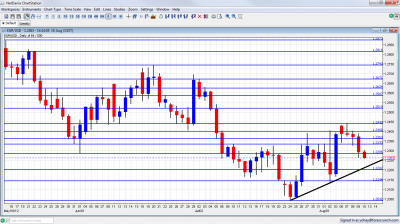Euro/dollar reached higher resistance but couldn’t follow through, as Spain didn’t follow through and submit an aid request. GDP figures for France and Germany as well as a major German survey are the highlights of this week. Here is an outlook for the upcoming events and an updated technical analysis for EUR/USD.
Doubts about the hinted Spanish aid request crept into the markets, as time passed by and Spain didn’t budge. Talk about growing German opposition to potential ECB bond buys and the uncertainty about Greece continue to haunt markets, especially as the head of the Eurogroup Juncker slipped a remark about Greece staying in the zone “at least until the autumn”. Positive data from the US certainly helped the other side of the pair.
Updates: German WPI posted a gain of 0.3%, beating the forecast of a flat 0.0%. This is a welcome sign of inflation in the German economy, indicating a slight increase in economic activity. The markets are waiting for Tuesday’s GDP figures out of France, Germany and the Euro-zone. The euro flexed some muscle to start the trading week, easily pushing across the 1.23 line. EUR/USD was trading at 1.2351. The markets were pleased with German Preliminary GDP, which rose 0.3%. This was slightly above the estimate of 0.2%. French Preliminary Non-Farm Payrolls declined -0.1%, matching the market forecast. German ZEW Economic Sentiment was a major disappointment, as the indicator fell to -25.5 points, its worst reading in 2012. The market estimate stood at -19.4 points. Euro-zone GDP (first reading) posted a loss of 0.2%, matching the estimate. Euro-zone Industrial Production dropped 0.6%, slightly more than the -0.5% prediction. Euro-zone ZEW Economic Sentiment improved to -21.2 points, but still fell short of the market estimate, which stood at -19.1 points. Greece’s GDP contracted in Q2 at annual rate of 6.2%, beating the estimate of a 7% decline. EUR/USD has lost some ground, as the pair was trading at 1.2344. The euro continues to drop following the release of strong US retail sales. Greece raised 4.063 billion euros in a government auction of three-month bonds, with a respectable yield of 4.43%. The sale was much larger than the previous one, and provides crucial funds as the country prepares to make a 3.2 billion euro bond repayment to the ECB later this month as part of the bailout package. The euro has dropped below the 1.23 line, as EUR/USD was trading at 1.2273. Euro-zone CPI jumped 2.4%, and Core CPI was up 1.7%. Both figures matched the market estimates. EUR/USD is choppy, as the pair was trading at 1.2283.
EUR/USD daily chart with support and resistance lines on it. Click to enlarge:
- German WPI: Monday, 6:00. German inflation numbers have influence on the ECB, especially concerning interest rates. After a big drop of 1.1% in wholesale prices, a small rise is expected now: 0.4%.
- French GDP (first release): Tuesday, 5:30. The euro-zone’s second largest economy surprised by growing in the fourth quarter of 2011, and remained flat in Q1 2012. PMIs and other indicators point to contraction in Q2. The consensus stands on -0.2%. Note that the final number usually confirms the first release, also in Germany’s case. Italy’s economy fell sharply, and also Spain contracted.
- German GDP (first release): Tuesday, 6:00. Germany’s strong 0.5% growth in Q1 saved the euro-zone from entering an official recession – it remained flat. However, the situation deteriorated in Q2, and growth is expected to fall to only 0.1%. A drop in Germany’s output will not be very surprising in the current environment.
- French Quarterly Non-Farm Payrolls: Tuesday, 6:45. The number of payrolls is published in France only once per quarter, making this figure more important. Q1 saw a surprising rise of 0.1% in jobs, after a 0.2% drop beforehand. Another drop of 0.1% is likely now.
- GDP (first release): Tuesday, 9:00. The initial GDP release for the euro-zone in Q2 is slightly overshadowed by the ZEW figure and the earlier releases of French, German, Italian and Spanish figures. Nevertheless, this figure is of high importance and will echo for quite some time. All the signs point to a contraction in Q2 after a flat Q1 and a squeeze of 0.3% beforehand. Contraction of 0.2% is likely now. Note that the estimates are likely to change once Germany and France release their figures.
- German ZEW Economic Sentiment: Tuesday, 9:00. This survey of 350 analysts and investors has a significant impact on the euro, and it certainly reflected the deteriorating in sentiment, falling in the past three months. The indicator reached -19.6 points last month, disappointing once again, and showing the growing pessimism in the German business community. A very small recovery is forecast for the month of July. The all-European figure, which is less important, is likely to tick up from the -22.3 points recorded last month.
- Industrial Production: Tuesday, 9:00. Industrial output surprised with by rising 0.6% in May. The tables have likely turned in June, as already seen in the German and French figures. A drop of 0.1% is expected now.
- CPI: Thursday, 9:00. The annual level of inflation is moving very slowly towards the 2% target. The initial figure of 2.4% will likely be confirmed in the final call now, or revised to 2.5%. Core CPI will likely stand on 1.6%.
- German PPI: Friday, 6:00. Producer prices fell short of expectations for three months in a row, and prices fell in the past two months. July will likely see a correction with a rise of 0.4%.
- Current Account: Friday, 8:00. While this is a relatively late figure, its wide scope (encompassing trade balance, services, flows, etc.) makes it of high important. The euro-zone enjoyed three consecutive months of surpluses, with a strong 10.9 billion euro surplus for May. June will probably see a lower figure of 7.8 billion.
- Trade Balance: Friday, 9:00. Also the his more narrow figure is positive, thanks to German exports. The surplus rose from 4.5 to 6.3 billion, and likely dropped now to 5.4 billion.
* All times are GMT
EUR/USD Technical Analysis
€/$ started the week with a move higher, but found resistance at the 1.2440 line (mentioned last week). It then began deteriorating, finding support at 1.2330, before falling to lower ground.
Technical lines from top to bottom:
The very round 1.30 line is a very important line in case of huge rally. In addition to being a round number, it also served as strong support. 1.29 is also notable on the upside, followed by 1.2814.
1.2750 capped the pair after the Greek elections and also had a similar role in the past. It is now of higher importance. 1.2670 was a double bottom during January and was the high line of the recovery before the Greek elections in June. It also capped the pair at the beginning of July 2012.
1.2623 is the previous 2012 low and remains important despite recent battles over this line. Below, 1.2587 is a clear bottom on the weekly charts but is only a minor line now.
1.2520 had an important role in holding the pair during June, in more than one case, but it’s much weaker now. 1.2440 provided support for the pair at the same time. and worked as double bottom.
It is closely followed by 1.24 that provided some resistance in June 2010 and switched to resistance in July. It is now of higher importance after capping a recovery attempt at the end of July and also at the beginning of August. 1.2360 was temporary support in July 2012 but quickly switched to resistance. It is minor now.
Further below, 1.2330 is another historical line after being the trough following the global financial meltdown in 2008. It’s stronger after working as strong support. It should be closely watched if the pair falls. The now previous 2012 low of 1.2288 is now minor support.
1.22 is now a more serious support line, after serving as such in June 2010. 1.2144 is already a very strong line on the downside: it was a clear separator two years ago, when Greece received its first bailout. Also in July and August 2012, it worked as a separator.
The new 2012 low of 1.2043 is the next line, although it may prove to be weak on a downfall. Next we have the 1.20 line, which is a round psychological figure.
The post crisis low of 1.1876 is the final frontier before lines last seen in the good years. The launch price of 1.17 is the next line.
Uptrend Support Emerging
As the graph shows, the pair is trading above uptrend support that was formed from mid July.
I am neutral on EUR/USD
The slow pace of events in Europe takes its toll on the single currency. Draghi did take a big step forward with an offer for full QE, but Spain probably needs another round of deterioration and more time for the public to prepare before it submits a formal aid request. Spain is also moving slowly, after hinting about such a request, and in the meantime, things are getting worse.
A Greek exit in 2012 is certainly on the cards (see how to trade the Grexit with EUR/USD), but the debt struck country will likely pass the upcoming hurdle of an August 20th bond repayment to the ECB: the ECB will help Greece pay the ECB, and this is supportive for the euro.
In the US, calls for QE from Eric Rosengren were countered by positive data, and the QE3 debate will likely be on hold this week.
If you have interest in a different way of trading currencies, check out the weekly binary options setups, including EUR/USD, GBP/JPY and more.
Further reading:
- For a broad view of all the week’s major events worldwide, read the USD outlook.
- For the Japanese yen, read the USD/JPY forecast.
- For GBP/USD (cable), look into the British Pound forecast.
- For the Australian dollar (Aussie), check out the AUD to USD forecast.
- For the New Zealand dollar (kiwi), read the NZD forecast.
- For the Swiss Franc, see the USD/CHF forecast.
- USD/CAD (loonie), check out the Canadian dollar forecast

